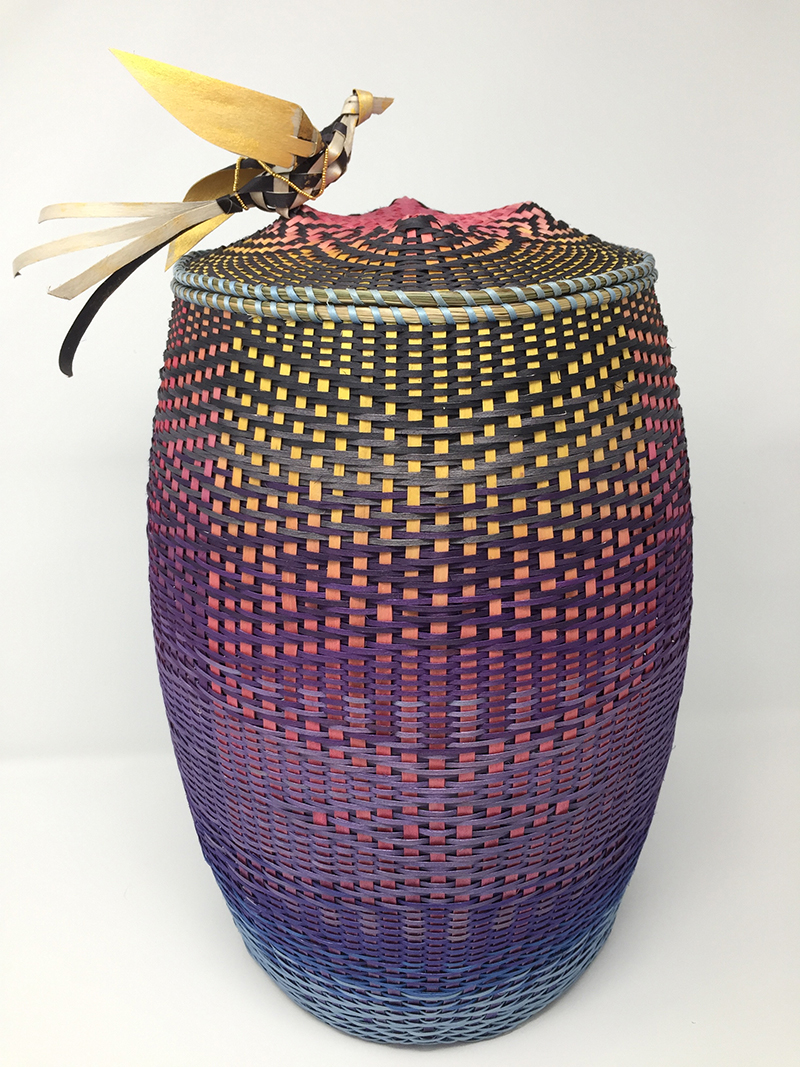Object of the Month: Geo Neptune’s "Apikcilu Binds the Sun"
By Bowdoin College Museum of Art
Basketmaking has served as the cornerstone of economic, cultural, and spiritual life of Wabanaki communities throughout the centuries. In more recent years, contemporary basketmakers have continued to revitalize the art form with idiosyncratic styles and innovative designs. Geo Soctomah Neptune’s basket, Apikcilu Binds the Sun (2018), is one such example that stunningly combines historically informed basketry with whimsical details and personal flare. As the youngest person to receive the title of Master Basketmaker, Neptune imbues this basket with spiritual meaning and cultural significance, while at the same time elevating oral traditions with their vibrant visual interpretation of a historic tale.
In Apikcilu Binds the Sun, Neptune presents the sequence of events between Apikcilu, the striped skunk, and Kishus, the Sun Bird, as part of the Wabanaki people’s creation story. The story follows Apikcilu’s pursuit for fame and recognition; out of vengeance, the striped skunk decides to bind Kisuhs’s wings and throw the world into unending darkness. The Sun Bird is rescued by Koluskap, the first person sent by the Creator and the one to bring Wabanaki people into the world. However, only one of her wings is freed, and she rests atop her mountain with one wing always extended and the other wing closed, thus casting one half of the world in daylight and the other half in shadow as she slowly turns. In turn, Koluskap punishes Apikcilu by staining his fur and marking him with an awful stench.
Through this storytelling basket, Neptune reimagines the cycles of night and day through their masterful manipulation of colors and form. The dyed strips create a rich gradation of yellow, pink, violet and indigo that simulates the sensation of seeing the rays of dawn. In addition, the basket’s circular forms and intricate weaving add a strong sense of movement. As we observe Apikcilu Binds the Sun in the round, the narrative therefore gradually unfolds and details such as the Sun Bird’s half black, half golden wings arrest our attention. Neptune’s basket reactivates the rich oral history of Wabanaki people and lends a distinctly contemporary lens to this fascinating story.
As we reflect on our current moment, it is equally befitting that this basket symbolizes a sense of emerging hope in times of darkness. Neptune explains that they believe Apikcilu has bound the sun once again, and we all must have faith that the sun will be freed and that light shall come. “Balance shall be restored to the natural cycle,” Neptune writes, “and Apikcilu’s white fur will be stained and smelly to remind him of what he has done.”
In addition to representing the tremendous accomplishments of Wabanaki artists in recent years, Neptune is also an educator and activist who advocates for cultural preservation and contemporary issues faced by Indigenous communities. Apikcilu Binds the Sun powerfully demonstrates the artistry, creativity, and resistance of Wabanaki people, and we are grateful to include this recent acquisition in the student-curated exhibition Innovation and Resilience Across Three Generations of Wabanaki Basket-Making, curated by three Bowdoin students, Amanda Cassano ’22, Sunshine Eaton ’22, and Shandiin Largo ’23. We look forward to sharing Neptune’s basket and other works in the exhibition with you.
Sabrina Lin ’21
Curatorial Assistant and Manager of Student Programs